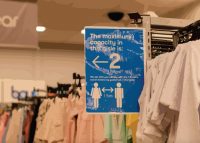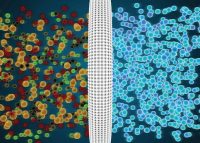As our nation slogs through the sweltering dog days of summer, most Americans are reaching for the thermostat. This summer however, that cool, ventilated air poses a greater risk. Health organizations around the world, including the CDC, are sending out warnings about the risk ventilated air poses in the transmission of COVID-19. Landlords and property managers seeking to keep their occupants safe are looking at costly HVAC technology improvements. Solutions are few and far between.
One of the earliest coronavirus studies published by the CDC showed that a single droplet from a diner at a 1,500 square foot restaurant in Guangzhou, China infected nine customers, dispersed by the building’s HVAC system. Several outbreak investigations have shown that COVID-19 transmission can be particularly dangerous in ventilated indoor spaces such as offices and factories. The role HVAC ventilation plays in transmission, like much of the virus itself, is still being discovered. While experts debate the details about ventilation’s role, all urge caution. The American Society of Heating, Refrigeration, and Air Conditioning Engineers (ASHRAE) has put together an Epidemic Task Force to provide guidance.
“The main way (air conditioning) can contribute to spreading coronavirus is by creating strong air currents that can move the droplets…and contribute to increased risk,” Chair of the ASHRAE Epidemic Task Force William Bahnfleth told USA Today.
The current state of most of the nation’s HVAC systems leaves us woefully unprepared. At best, most HVAC systems in commercial buildings can only control ventilation by increasing the outdoor air ventilation rate. Even then, there’s no understanding of how much outside air is enough to diffuse virus particles. Improving filtration is hardly an option. Most of America’s commercial and residential building’s use a Minimum Efficiency Reporting Value (MERV) on their air filters somewhere between six and eight, which are not capable of filtering out the tiny aerosol droplets containing the virus. Simply installing better filters restricts airflow to the system by forcing the air through smaller pores, which most systems wouldn’t be able to handle, causing a total failure or extreme inefficiency. Opening windows seems to be the only practical advice property managers can follow.
Read more



“Opening up the windows is easy and cheap. But what about actually changing the ventilation system of a big building?” Director of Harvard’s Healthy Buildings Program Joe Allen told CBS News. That’s no easy feat, but there’s evidence to show some HVAC technology can work.
“What’s the best example I can give you? Medical office buildings,” Chairman of Americas Research and Senior Economic Advisor for CBRE Spencer Levy said during a recent webinar for NAIOP Maryland members. “They have a higher standard of care regarding things like better HVAC. You may see that type of thing become more standard in offices going forward.”
Levy predicts HVAC technologies used in health care facilities could start to show up in commercial buildings. ASHRAE’s guidance for commercial buildings has been adapted from their recommendations for hospitals and other medical facilities. Addressing airborne infections in healthcare facilities means integrating HVAC and air-pressure-control with a dedicated infection-control system that minimizes unplanned airflows. Healthcare facilities use four methods to fight airborne infections: filtration, dilution, pressurization, and disinfection. Only one is a viable option outside of the medical field.
Filtration is the first line of defense. High-Efficiency Particulate Air (HEPA) filters are a powerful weapon against airborne ailments, capable of filtering out droplets under three microns, the size of droplets holding the coronavirus. HEPA filtration systems are typically rated between seventeen and twenty MERV, far above what standard commercial HVAC systems can handle, making them unfeasible. Dilution works by mixing in more outdoor air into the HVAC system. Diluting a typical commercial system with enough outside air to be an effective solution, especially during a blistering summer, wreaks a system’s efficiency, making it unable to keep air cold while the electric bill skyrockets.
Hospitals have complex ventilation technology that can adjust pressure by room, creating pressurization dynamics to stop airflow. Isolation and quarantine rooms in hospitals use negative pressure. For a negative pressure room, each room has its own filtration and exhaust system that is not being recirculated. Air flows in, is filtered, then flows outside, keeping a constant negative pressure and preventing air from flowing out of the room. Negative pressure rooms are a silver-bullet against the spread of airborne disease, but even hospitals are struggling to meet the demand for more.
Hospital-style disinfection may be a viable solution for commercial buildings. In hospitals, special ultraviolet (UV-C) devices are installed in ventilation ducts, using ultraviolet radiation to destroy all microorganisms that pass through. There’s strong evidence to suggest UV-C light can kill COVID-19. Due to the dangers of the radiation to the human eye, the devices must be installed in ducts in the ceiling, far out of sight. UV-C systems are some of the oldest forms of air quality technology deployed in medical buildings. Ultraviolet technology is being widely deployed in office buildings for surface decontamination, but so far using the technology to disinfect the air has been limited to medical settings and airports.
“We advocate the widespread use of UV-C light as a short-term, easily deployable, and affordable way to limit virus spread in the current SARS-CoV-2 pandemic,” Researchers from the Institute of Photonic Sciences in Spain said in a recent study published in the Journal of ACS Nano. ASHRAE’s 57,000 HVAC engineers agree. In a recent release from their pandemic taskforce, the group advocates for UV disinfection as part of HVAC disinfection and disease mitigation.
It should be said, these UV lights aren’t cheap, ranging from $200 to $1500 each, depending on the size, plus installation. Disinfecting the air in-duct requires dozens of the lights, but a more limited approach, aimed at disinfecting air at the coil, requires fewer lights with more circulation. Demand for UV-C lights is strong, so expanding sales and production may reduce pricing. When compared to replacing an entire HVAC system that can handle HEPA filters, they’re a cost-effective option for covid prevention. For many facility managers, they may be the only option.
“[UV-C Technology] is a well-proven, extremely safe technology that is underused and often misunderstood,” Dr. Edward Nardell, a professor at Harvard Medical School, told NPR. “No one doubts the efficacy of germicidal UV in killing small microorganisms and pathogens. I think the bigger controversy, if there is any, is misperceptions around safety.”
Public perception has shifted against UV over the decades, as UV light strong enough to disinfect has been proven to damage the eyes and skin. Nardell says those risks can be avoided if the appropriate guidelines are followed, like keeping all devices out of sight. Just like with any ultraviolet technology, from teeth whiteners to tanning beds, proper precautions must be taken. The biggest issue may be the market for the UV-C products itself. After dealing with skewed public perception for decades, the industry is limited in scope. The global market for UV-C light barely reaches one billion annually, so it may struggle with the expected rise in demand generated by the pandemic, according to the researchers in Spain.
Each property manager will make their own decision, but it’s important to have the facts first. Surface cleaning and social distancing will not be enough. Improving filters may ease the fears of occupants, but will do little to tackle COVID prevention. More outside ventilation will help, but elevated risks still remain. With few options and a stretched budget, turning towards ultraviolet technology for your property is a bright idea. [Propmodo]
